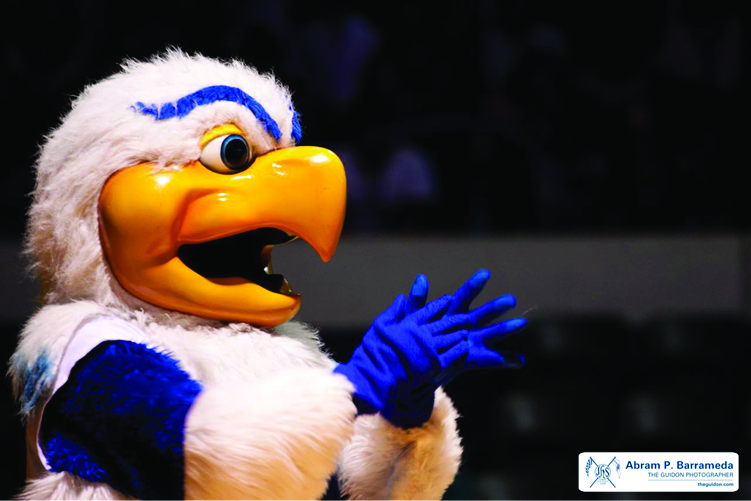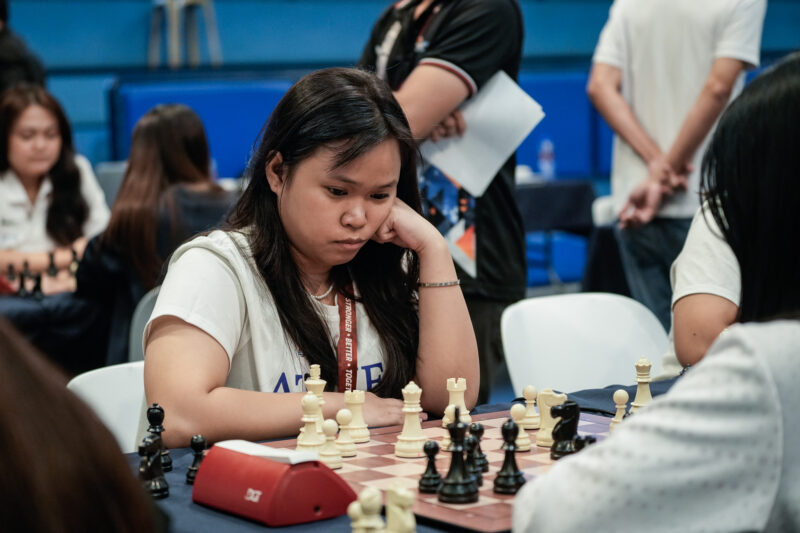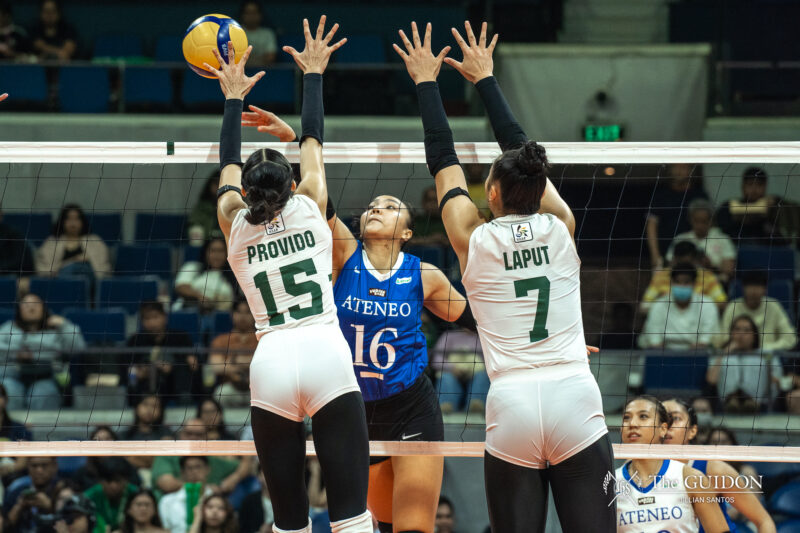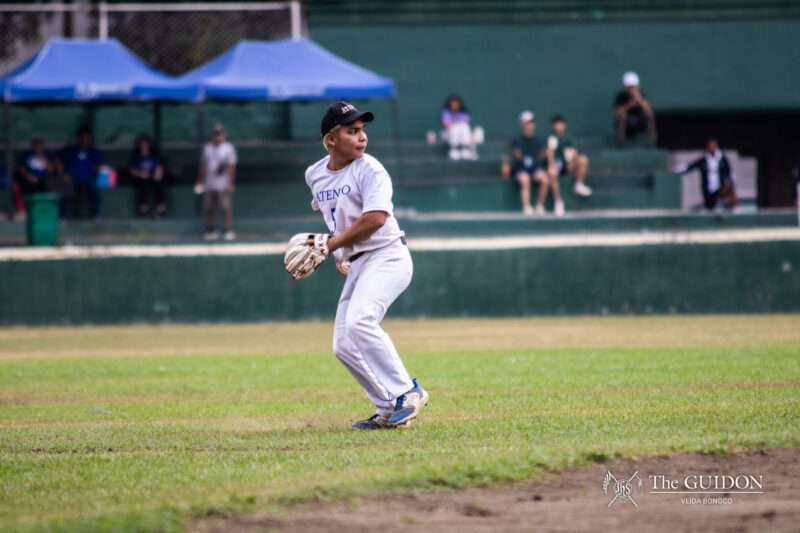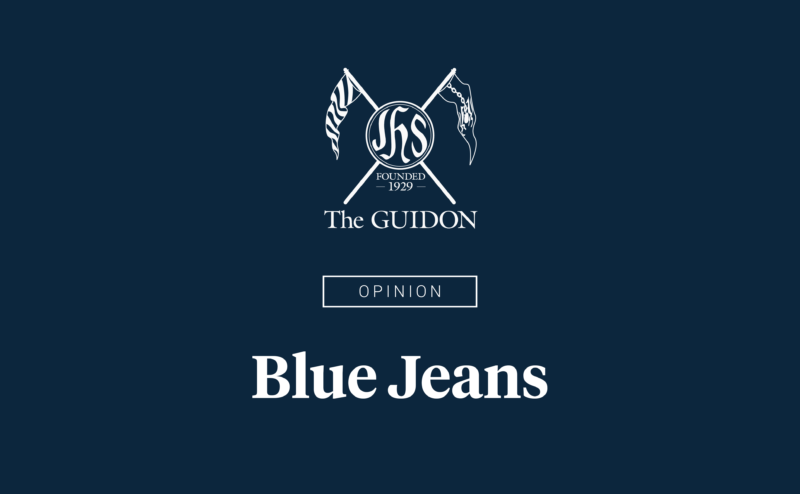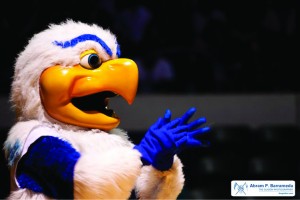
FIRST IN LINE. Ateneo became the first Philippine school to adopt a mascot when it introduced the Blue Eagle. (Photo by Abram P. Barrameda)
ATHLETES WHO don the Ateneo’s blue and white jerseys are constantly rewriting the history of their respective sports. Our university’s athletic track record has seen countless victories and defeats, but there exists a single constant, an icon that has served as both an emblem of valor and a crest of virtuosity for each member of our institution: The Blue Eagle.
First flight
Today, the Blue Eagle has become one of the most important icons of the Ateneo’s identity. Despite this fact, the story of how the Blue Eagle came to be is not something every member of the Ateneo community is aware of.
Most Catholic schools derive their names directly from their patron saints. Prior to the emergence of school icons, local newspapers and school publications would have to make use of headlines such as, “St. Paul overthrows St. Jude” or “St. Ignatius beats St. Thomas” when discussing collegiate sports.
According to the details written on the back cover of the record album The Marching Songs of Raul Manglapus, to veer away from this, a phenomenon began in the United States sometime during the 1930s that saw the various Catholic Schools adopting team mascots or monikers in place of the names of the different saints. It was this trend that led the Ateneo to establish the Blue Eagle as the official mascot of the entire institution in 1938.
The eagle was a fitting choice for a university mascot. “The Eagle—fiery, majestic, whose kingdom is the virgin sky, is swift in pursuit, terrible in battle. He is a king—a fighting king,” wrote Lamberto V. Avellana in the booklet“On the Wings of Blue.” A powerful, majestic creature, the eagle aptly represents the “high-flying” varsity teams, particularly the basketball squad.
Avellana’s booklet further explains the reason behind the choice of an eagle. “Thus he was chosen—to soar with scholar’s thought and word high into the regions of truth and excellence, to flap his glorious wings and cast his ominous shadow below, even as the student crusader would instill fear in those who would battle against the Cross… And so he was chosen—and he lives, not only in body to soar over his campus eerie, but in spirit, in the Ateneo Spirit… For he flies high, and he is a fighter, and he is King!”
That said, the Blue Eagle—the color of which was adapted from the colors of Mother Mary, the patron saint of the Ateneo—is much more than just a school mascot. The Blue Eagle is a symbol that encompasses what it truly means to be an Atenean.

FIRST IN LINE. Ateneo became the first Philippine school to adopt a mascot when it introduced the Blue Eagle. (Photo Abram P. Barrameda)
Trickling down to tradition
Shortly after being established as the official mascot of the university, the Blue Eagle slowly trickled down into the other traditions of the university. It found its way into the hearts of Ateneans, becoming the staple of cheers, battle cries and fighting songs during sporting events.
Manglapus composed one of the Ateneo’s most famous fight songs directly following the summer of the Blue Eagle’s conception. He created “Blue Eagle, The King” to further emphasize and establish the newfound symbol of the school.
As written in The GUIDON’s June 1939 issue, many considered “Blue Eagle, The King” a stepping-stone for local cheerleading. It was the only fight song of its time whose music and lyrics were exclusively composed for it.
As an attempt to inspire Ateneans both on and off the court, Manglapus wrote lines that echoed the boldness of the Ateneo spirit. “For the Eagle’s the King of them all, and his Blue Feathers never shall fall,” wrote Manglapus. “For the Blue and the White, Ateneo will fight. Ateneo will fight today.”
The massive influence of the song on the Ateneo culture remains as it is not only the battle cry of the Blue and White community during Basketball games, but also one of the first few things young boys learn upon entering the Ateneo for the first time.
Aside from finding its way into cheers and fight songs, the Blue Eagle was also turned into a live mascot. The Blue Babble Battalion currently uses a costume to represent the Blue Eagle, but this wasn’t always the case. The school initially brought live eagles with them into the stadium sometime during the 1960s, but most notably during Ateneo’s championship runs from the late 1970s to a little before 1990.
The Blue Babble Battalion used to borrow Dick Gordon’s eagle from Olongapo to bring along with them to the Rizal Memorial Coliseum. “Iyong eagle kasi na iyon ay kay Dick Gordon sa Olongapo. Noong nag-back-to-back champion ‘yung Ateneo versus La Salle, hinihiram ng Blue Babble Battalion tapos iyon ang pinapalipad nila sa Rizal (That eagle belonged to Dick Gordon in Olongapo. It was when Ateneo became back-to-back champions versus La Salle that the Blue Babble Battalion started borrowing it and bringing it with them to Rizal)” shares Loyola Schools Biology Laboratory Technician Roger Domingo.
There came a time, however, when they had to tape the Eagle’s beak in order to keep it from inflicting harm on others. “Nanunuka kasi ‘yung eagle, kaya ‘yung ginawa nila ay nilagyan nila ng masking tape (The eagle used to peck which forced them to tape its beak),” adds Domingo.
Unfortunately, the eagle suffocated during one of the games and Domingo was instructed to stuff and preserve its exterior. The Battalion tried to return the stuffed Eagle to Gordon, but he decided to instead donate it to the university’s Biology department. It can now be found in one of the glass panes along SEC-B.
Today, the Battalion has opted for a more conventional practice as the various team managers of the Battalion take turns in wearing the costume and taking part of the routine by waving the school flag as the squad executes its routine alongside the mascot.
Contrary to popular belief though, not all the varsity teams of the Ateneo are referred to as Blue Eagles. Since the moniker was chosen primarily because of the skills of the initial Ateneo Basketball Teams, it is only this same team that is currently called the Blue Eagles while every other varsity team has its own moniker adapted from the original.
As the years have passed, the Blue Eagle has slowly evolved into a brand of its own. But throughout these years, it has remained a constant symbol of the kind of athlete and student that Ateneo hopes to develop. It has become an important facet of the culture that exists within the Ateneo community. It is something that has taken on a life of its own and one that will continue to transform in the years to come.
|
Sport |
Men’s |
Women’s |
| Basketball | Blue Eagles | Lady Eagles |
| Football | Blue Booters | Lady Booters |
| Volleyball | Blue Spikers | Lady Spikers |
| Beach Volleyball | Blue Beach Spikers | Lady Beach Spikers |
| Baseball | Blue Batters | |
| Softball | Lady Batters | |
| Badminton | Blue Shuttlers | Lady Shuttlers |
| Tennis | Blue Netters | Lady Netters |
| Table Tennis | Blue Paddlers | Lady Paddlers |
| Track & Field | Blue Tracksters | Lady Tracksters |
| Swimming | Blue Tankers | Lady Tankers |
| Fencing | Blue Fencers | Lady Fencers |
| Judo | Blue Judokas | Lady Judokas |
| Taekwondo | Blue Jins | Lady Jins |
| Chess | Blue Woodpushers | Lady Woodpushers |
What do you think about this story? Send your comments and suggestions here: tgdn.co/2ZqqodZ

